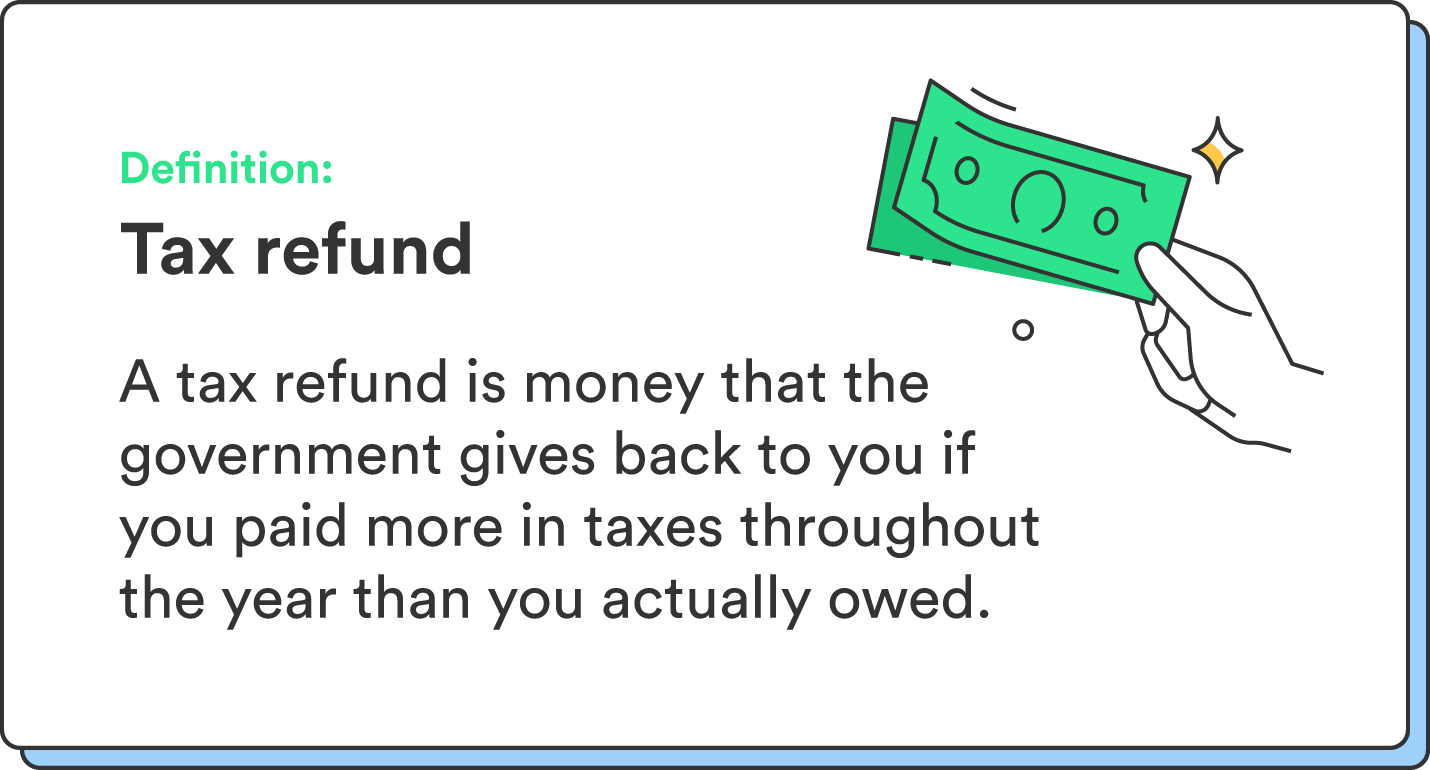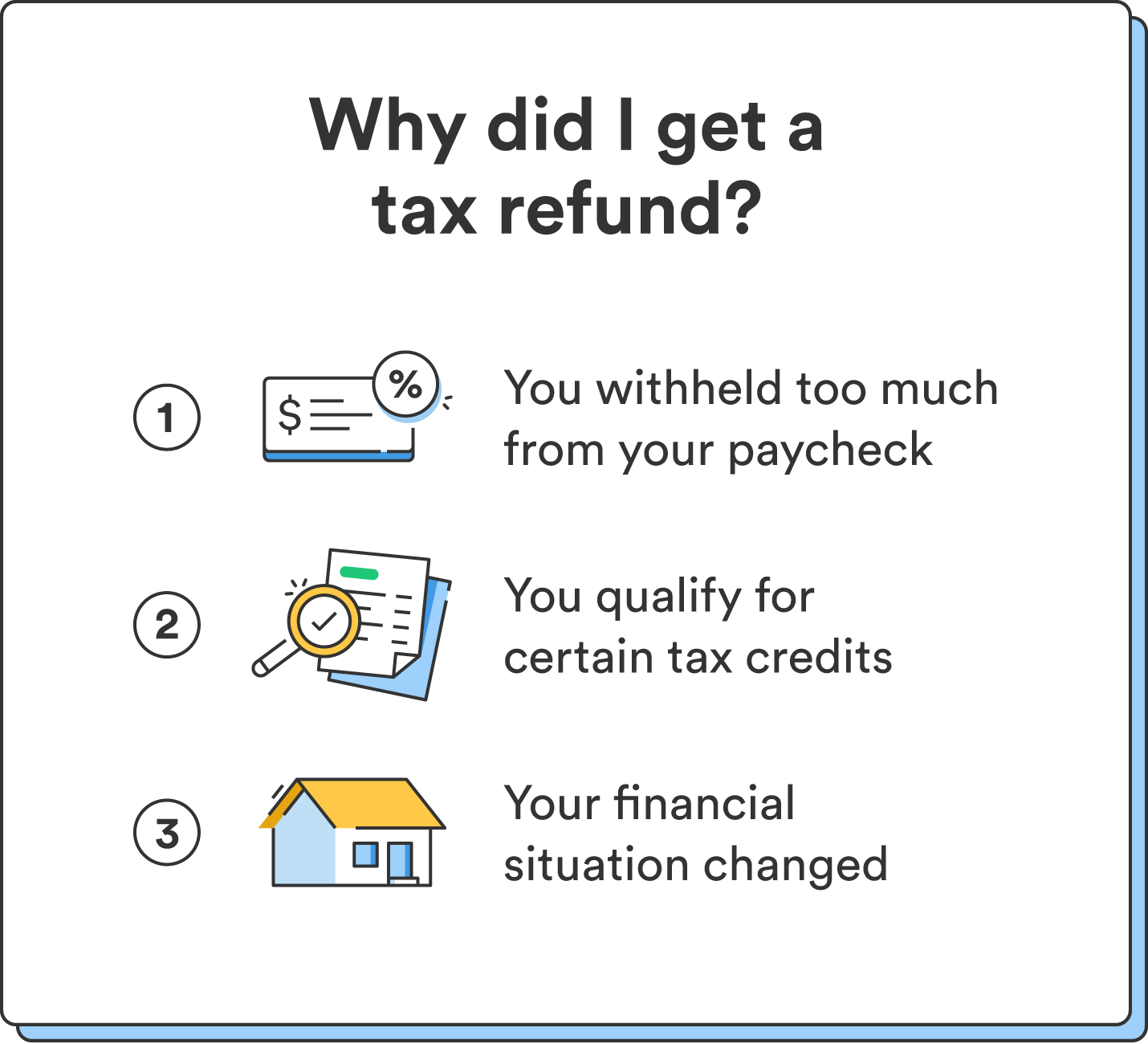Tax refunds involve the amount of taxes you pay from your paycheck throughout the year. Knowing how they work can give you more control over your money and avoid any surprises once tax season rolls around. Read on to learn what a tax refund is and when yours will be issued.
What is a tax refund?
A tax refund is money that the government gives back if you paid more in taxes throughout the year than you owed. This overpayment results from employers withholding too much money from your paychecks.
Instead of waiting for a yearly refund, you can adjust your tax withholding to avoid overpaying your taxes and keep more of your paycheck month to month.

How do tax refunds work?
While a federal tax refund may seem like a pleasant financial surprise, it’s just the government returning the extra money you paid them in taxes. In other words, money that could have been in your pocket throughout the year.
Check out this breakdown of how tax refunds work:
- Income taxes: When you earn money, your employer sends a portion of your paycheck to the IRS to cover the income taxes you owe.
- W-4 Form: As an employee, you specify the amount of taxes you want withheld from each paycheck on your W-4 form.
- Annual tax filing: When you file your taxes, your annual tax return should accurately detail your earnings, deductions, and credits.
- Calculating tax liability: The government calculates how much you owe in taxes based on your tax bracket and the information you provided in your tax return.
- Comparing withheld amount: The IRS compares the amount you withheld to your actual tax liability.
You’ll receive an IRS refund if you paid too much in taxes. You may owe the IRS additional taxes if you underpaid. If you want to estimate your tax refund, you could use an online tax calculator to make sure you’re not over or under paying.
Understanding tax refunds
Not everyone will receive a tax refund come tax season. Here are four common scenarios that can lead to receiving a tax refund:
- Withholding too much from your paychecks: If you filled out your W-4 to have a higher withholding amount that exceeds how much you owe in taxes, you may have more money taken from each paycheck than necessary, resulting in a tax refund. You might do this intentionally or in error.
- Receiving refunds for tax credits and deductions: “Refundable” tax credits and deductions, like the Earned Income Tax Credit (EITC) or the Child Tax Credit, can lead to a refund even with a low tax liability.¹ For example, if you qualify for a refundable tax credit of $1,000 but only owe $800 in taxes, the IRS returns the extra $200 as a refund.
- Experiencing changes in your financial situation: Significant life changes, like getting married, having a child, or buying a home, can impact your tax situation. These changes may lead to additional tax credits or deductions, increasing the likelihood of a refund.
- Overpaying your quarterly estimated taxes: If you’re a freelancer or self-employed, you have to pay estimated taxes throughout the year.² Under-paying or filing taxes late can lead to a penalty, so you might over-pay to avoid any fines and consequently receive a tax refund.

Refundable tax credits
The most valuable tax credits are refundable tax credits, as opposed to nonrefundable ones. With a refundable tax credit, you receive the full amount of the credit, even if it reduces your tax liability to zero. By contrast, a nonrefundable tax credit can only reduce your liability to $0 and no more. You won’t get the remaining amount of the credit after that point.³
Here are some refundable tax credits that might provide you with a tax refund.
Child Tax Credit (CTC)
The Child Tax Credit goes up to $2,000 for qualifying taxpayers with children under the age of 17. Up to $1,700 of this amount is fully refundable in 2024.⁴ Annual income limits to qualify for this credit are set at $200,000 for individuals and $400,000 for joint filers.⁵
Earned Income Tax Credit (EITC)
The Earned Income Tax Credit goes up to $7,830 in 2024.⁶ You might qualify for the EITC if your income is low to moderate. The amount you can claim also depends on whether you have children, have dependents, are disabled, or meet other criteria.¹
American Opportunity Tax Credit (AOTC)
The American Opportunity Tax Credit offers up to $2,500 if you paid for qualified higher education expenses for an eligible student. This credit is partially refundable. If it brings your tax liability to $0, you could receive 40% of the remaining amount up to $1,000.⁷
Premium Tax Credit (PTC)
The Premium Tax Credit helps eligible taxpayers pay for the premiums on health insurance purchased through the Health Insurance Marketplace. Some eligibility requirements include meeting annual income limits, not being able to get affordable coverage through an employer-sponsored plan, and not being eligible for a government program like Medicaid or Medicare.⁸
The amount of the Premium Tax Credit is usually equal to the premium for the second lowest-cost silver plan available through the marketplace, minus a percentage of your household income.⁹
When will I get my tax refund?
The exact time frame for receiving your tax refund varies, but you can expect to receive your refund within 21 days if you file your taxes online and request direct deposit.¹⁰
The timeline for how long it takes to get a tax refund can change depending on the IRS’s workload and any issues with your return.
Take the stress out of tax season
Instead of waiting for a yearly tax refund, learning the ins and outs of how tax refunds work can help you keep more of your hard-earned money throughout the year. Utilize tools like the IRS withholding estimator and, if necessary, update your W-4 to match your financial situation.
When you’re ready to file, find out if you can pay your taxes with a credit card.
FAQs
How do I check the status of my tax refund?
To check the status of your tax refund, use the IRS’s Refund Status tool. You can use this tool beginning 48 hours after the IRS receives your tax return.¹⁰
What should I do with my tax refund?
If you receive a tax refund, consider using it strategically to further your financial goals. Whether building an emergency fund, paying down debt, or investing in long-term savings, your refund can contribute to a more secure financial future.
Does everyone get a tax refund?
Not everyone receives a tax refund. It depends on factors like income, deductions, and tax credits. While some may get a refund, others might owe additional taxes or have a balance that breaks even.

 Log in
Log in
